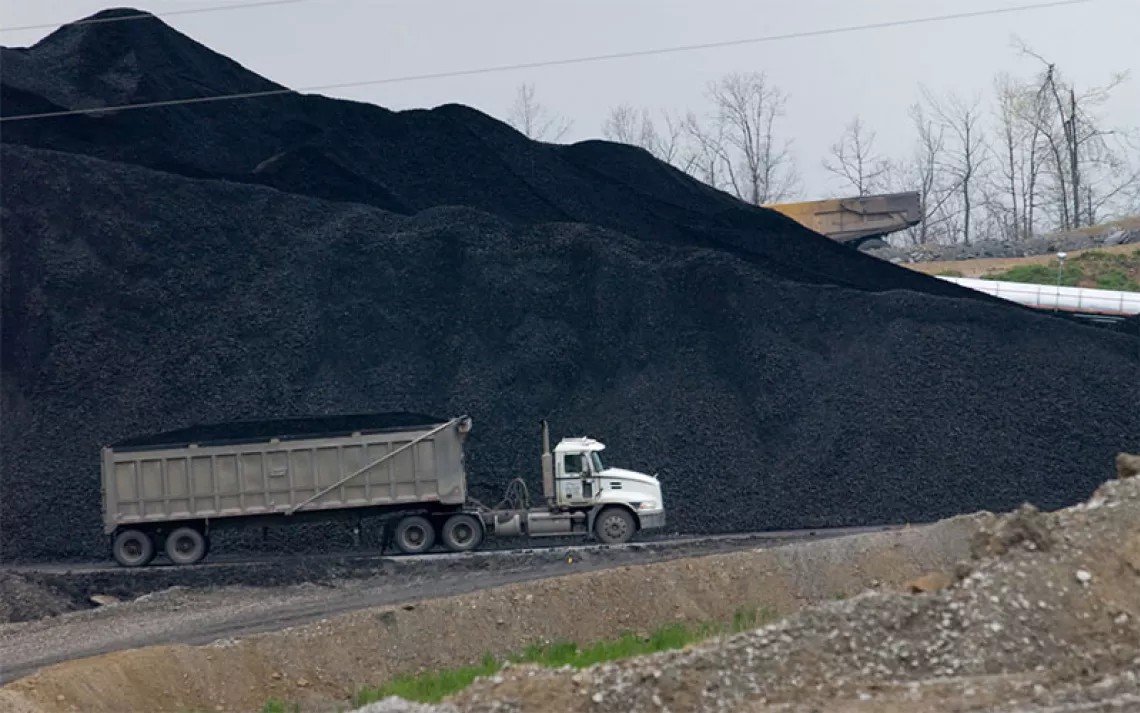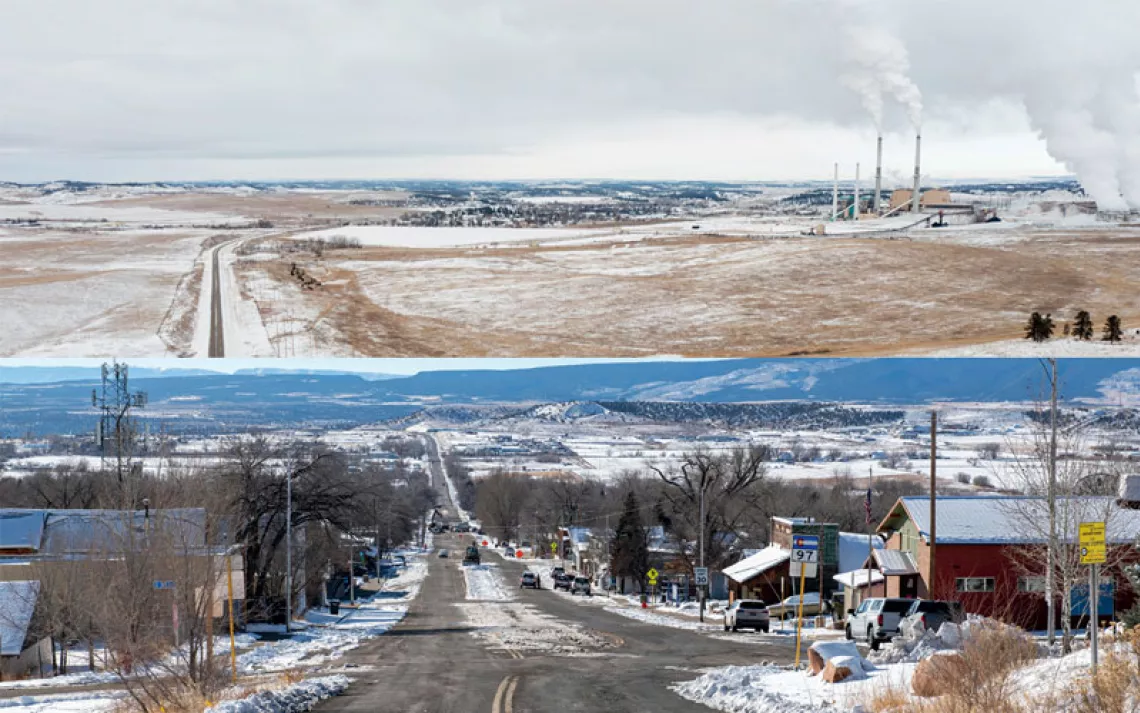An Indian Coal Plant's Human Rights Crisis
In a little-known pocket of India, jungles and communities have been leveled by decades of power plant development. The latest project was financed by U.S. taxpayer dollars.
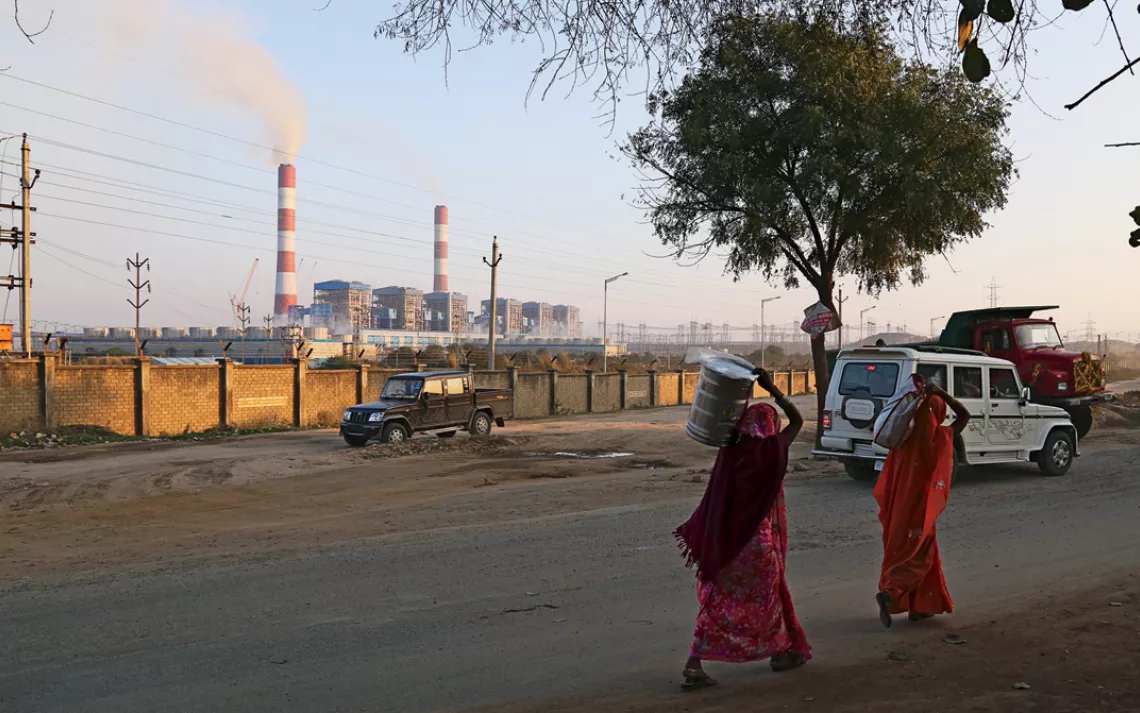
The Sasan Ultra Mega Power Project in Madhya Pradesh, India.
JUST PAST THE SIGN welcoming visitors to Surya Vihar, a collection of abandoned yellow houses bake in the afternoon light. The name of the place once held a promise: Sun Colony. Instead, it has become a tableau of shattered glass, barred windows, and dirt expanses. The time of promise seems to have come and gone.
Sameer is one of the people who believed in the future of Surya Vihar. I find him on the single road that runs through the partially abandoned colony, his purple and gray scarf tailing in the wind. A few motorcyclists whiz past—some carry bundles of coal that they scavenged from the edge of a nearby mine; others, cords of firewood—but nobody stops. "We left this place because we could not farm or graze our animals here," Sameer says, motioning toward the broken windows and endless fields of dirt.
Before coming here, Sameer lived a few miles away, on sprawling grassland where the villagers kept animals and grew much of their food. (Sameer is not his real name. He spoke on the condition of anonymity, afraid of being beaten for talking to a journalist.) A few years ago, a representative of Reliance Power, one of the largest power companies in India, told him that his village was scheduled to be razed so that a pond could be dug in its place. The pond would hold ash slurry from the Sasan Ultra Mega Power Project, a coal-fired power plant that Reliance was building. The company wanted to pay Sameer for his house and move him to a new village.
Sameer was hesitant to sell his property for 200,000 rupees (about $3,200) per acre, a far lower price than the 600,000 to 700,000 rupees per acre he believed the property was worth. But he was enticed by the picture of the new colony—it would include a hospital and a school, both of which Sameer lacked easy access to—and the permanent job that Reliance was offering him. Reliance told Sameer that the low purchase price would allow the company to offer the amenities to him and his neighbors.
When he was ready to sell, Sameer was bused to the government office in Waidhan, about 20 miles away. Inside the building, he was invited into a large tent containing rows upon rows of the most luxurious beds he had ever seen. There was a massive array of food—samosas, milk sweets, puri—all free of charge. People streamed in all day, maybe 200 total, Sameer said, and for hours they were treated like royalty. After laying eyes on this preview of their new life, the villagers were called one by one into another room, where they signed over their property to Reliance. Sameer relaxed in that tent late into the night before being bused home.
Soon after, the people were moved to Surya Vihar, where the land was infertile and there was no hospital. Few of the villagers received pensions or permanent jobs. There was a school, but many of the children were not allowed to enroll. People who had relied on their fields for food and income had expected permanent jobs in their new lives, but the jobs were not given, and they were suddenly without money or property. Within a few years, nearly everyone had moved away.
There was no moving back to their original homes. Where Sameer's house once stood, there is now an ash pond, and the ruins of his village lie like sunken ships on the pond floor.
ENTIRE COMMUNITIES IN INDIA ARE regularly displaced to make way for industrial projects. Depending on where the land is located and how its inhabitants have used it, the displaced might be legally entitled to compensation packages that include a permanent job for each family, construction of a dwelling in another location, or payment for the land itself. But even when the laws are enforced, this displacement can be devastating for those affected by it.
"In 99 cases out of 100, the displaced are worse off than they were before," said Ashish Fernandes, a senior campaigner for Greenpeace India.
Singrauli, the remote region of central India where the Sasan plant is located, is a microcosm of the nation's displacement and pollution problems. Spread across the fertile Gangetic Plain, the area was a biologically rich patchwork of jungle and grassland until the 1960s, when the Indian government erected the Rihand Dam, a hydroelectric station that displaced 100,000 people. The power produced by the dam invited a stream of factories, coal-fired power stations, and open-pit coal mines, each requiring large-scale displacements. As plants and dump sites shove aside the relocation colonies from earlier displacements, thousands of families are forced to move for the second, third, and fourth time.
The Sasan power station—the one that displaced Sameer—is one of the newest in Singrauli. It is also the only one that was enabled by $650 million in U.S. taxpayer dollars, by way of financing from the Export-Import Bank of the United States. Reliance Power used that money to import U.S.-made mining equipment, supporting 1,000 U.S. jobs, according to the bank. (Reliance did not respond to numerous requests for comment.) The project passed an environmental and social impact review conducted by the bank's specialists, despite the fact that, largely because of preexisting power plants, the area has one of the highest pollution indexes in India, one of the world's most polluted countries. A 2012 study that tested for heavy metals in drinking water and the bodies of Singrauli residents determined that most of the water tested was "not suitable for drinking" and found an average blood mercury concentration of 34 parts per billion—five times the safe limit set by the U.S. Environmental Protection Agency. The Sasan plant appears to be continuing this legacy. A sheet cannot hang in any nearby village without turning black, slurry flows through the ash-pond levee, and the plant's peppermint-stripe towers can be seen coughing brown smoke from miles around.
The environmental and social impact assessments conducted for the Sasan plant stated that the power station would "bring about economic prosperity in the area" and "provide employment for the local population." But the project, like its predecessors, has just led to more suffering.
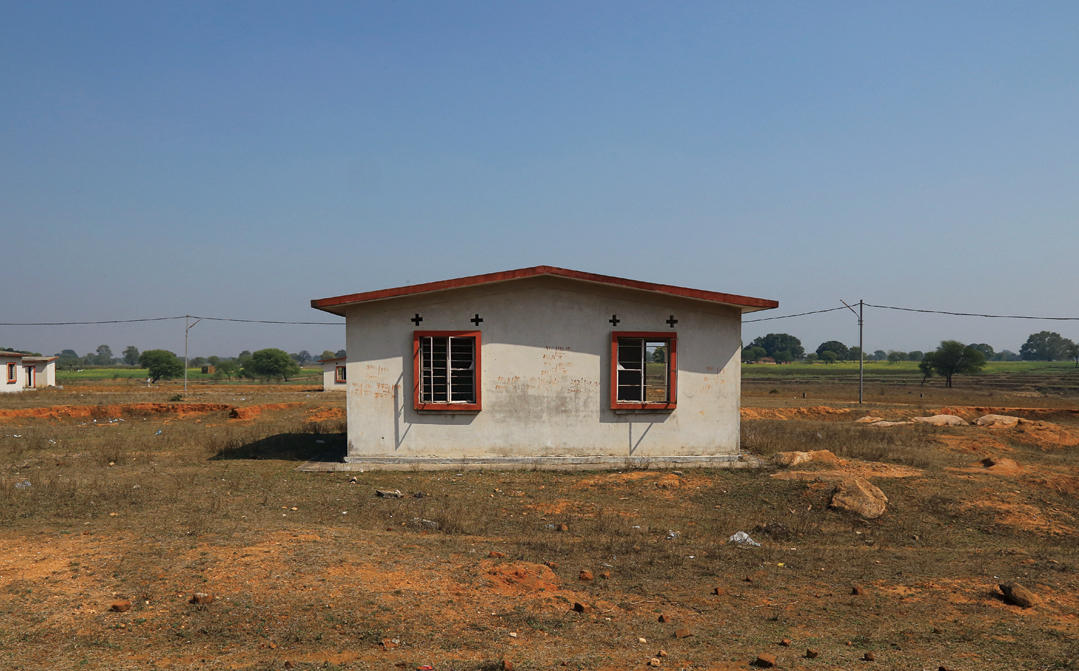
Surya Vihar, a relocation colony established by Reliance Power, was abandoned by many residents because they found it unlivable.
ON A GRAY WINTER DAY, beneath a sky full-bellied with clouds, the displaced wander aimlessly around Krishna Vihar, a relocation colony set up for a few dozen families whose village, Amlohri, was located atop a seam of coal destined for the Sasan plant. They are Baiga tribals, wrested from the jungle where they and their forebears spent long days gathering food, herbs, and water from the wild. Some of them are crying in the open. They long for food-bearing trees and shrouded places to go to the bathroom. Most of all, they just want to go home.
To some of the people, like Jitlal Baiga, displacement came in the guise of a chance to live a less arduous life. The process began for him when a short, portly man from the city walked up to his jungle doorstep and offered him a house in Krishna Vihar—said to be a newly built village complete with a hospital, a school, and electricity—along with a pension and monthly allowances of oil and grain. It sounded like a lovely place. Jitlal found no reason to doubt the man's word. "It was a high officer making this promise, so he accepted," says Jitlal's son, Nandlal. After loading their few possessions into large trailers, an early wave of Amlohrians, Jitlal included, were taken to Krishna Vihar.
What they found when they got here was a collection of small houses in a barren place beside the road. Some of the families were placed in two- or three-room homes, even though Amlohri families often included up to 12 members. The least fortunate among them were not even given houses.
For the Baiga from Amlohri, displacement presents a unique challenge because they aren't versed in a life of consumption. "These are people who are not used to living on cash, and all of a sudden, they are given an amount of money and asked to subsist," says Joe Athialy, acting Asia director at the Bank Information Center, who has visited Singrauli on several fact-finding missions. "In a few years, all of that money is gone. They are not going to make money somewhere else because they are not used to living that way."
On the street in Krishna Vihar, a slender, mustachioed man named Babura tells me that living here costs about 50 percent more than living in the jungle. But despite his financial struggles, he has adjusted well to his new life. The same cannot be said for his neighbor Ram Lakhan, who has often said to his wife, "I think when I die, only then will we get land, compensation, and jobs." (He would hang himself a few months after I left.) Nor does it apply to a sobbing woman named Sitaram, who describes how her husband has been through hepatitis twice and a string of other, undiagnosed illnesses since they were all but forced to move here in 2011. She believes that the cause of his illness is this barren patch of ground, and that the cure can be found in the plants of the jungle. "Why can't they just drop us in the forest and let us live there?" she asks me, as if I know the answer.
Like those displaced to Surya Vihar, the people here can never return to their village. Much of it has been burned to the ground. Where lush forest, tigers, and langurs once thrived, the skeletons of buildings are now buried beneath overburden, the mounds of rock and flora that need to be dumped somewhere so coal can be mined.
A few last Amlohrians have moved back to a part of the jungle that has yet to be excavated. One of them is Jitlal's son, Nandlal. In 2011, as the rains were just beginning, Reliance officials ordered Nandlal and his family to relocate to Krishna Vihar, where they were given a plot with no house. They built a jompri—a temporary shelter—and lived on the plot for six months before deciding that a move back to the forest, although illegal, was worth the risk. "We were not a family because we didn't have our forest," Nandlal says. "We thought we would die in Krishna Vihar."
For now, Nandlal and his large family live in an oasis of forest surrounded by overburden and open mines. The place is bountiful, but it won't last much longer. Some women from his community were caught by mine guards while gathering firewood and detained for several hours, and every few evenings the guards amble up to their settlement and accuse them of stealing fruit from vegetation owned by Reliance. The only water source is a tepid pool down the hill. It's clouded with silt from the overburden and makes his children ill.
"We will live here until our house is under the rubble," Nandlal tells me in the jungle behind his house, bobbing one daughter on his hip and holding the hand of another. From his front door, you can hear the distant grind of machinery. It gets steadily louder, he says, as the mine's border expands toward his home.

Nandlal Baiga, outside his home, which sits atop a coal deposit in India.
SOME LOCALS HAVE SPOKEN OUT against the Sasan displacement, only to be opposed by the local government and police force. "The atmosphere is quite intimidating to the people," said Athialy, of the Bank Information Center. "Many people have raised their voices and been attacked by the police or the plant officers."
"In many cases, the local constabulary and district administration feel that their responsibility is to support the company involved," added Greenpeace's Fernandes. "Anyone opposing these projects is a threat. The government has emboldened companies to be more aggressive and police forces to do whatever they want to manage the dissent."
A man named Sati Prasad is one such dissenter, and the response to his efforts has been brutal. For years, he has encouraged his former neighbors (he once lived where the Sasan plant itself now stands) to file complaints about the compensation they haven't received and the intimidation tactics of the police and Reliance employees. In November 2013, Prasad organized a protest to take place outside the gates of the power plant. He was demanding that Reliance follow through on its promise to give permanent jobs to the people of his former village.
And there was something else: His friend Sudarshan Rajak had disappeared under mysterious circumstances in 2009, and Prasad felt that the incident had not been thoroughly investigated. Rajak, whose house had been located on the future grounds of the power plant, had refused to sell his property to Reliance for what he believed to be a lowball offer. In the days leading up to his disappearance, Rajak claimed to have received calls from police officers who said that if he did not sell, they would beat him until he "vanished into the ground." Some people, Prasad included, suspected that Rajak's house had been razed while he was still inside.
The day before the protest, the police came looking for Prasad. They called him repeatedly, asking, "Where are you, Sati Prasad?" After phoning a few friends to express his worries, eating a dinner of roti and vegetables, and going to sleep, he woke to the sound of a policeman shouting through rain. The voice said, "Get out of there, Prasad. You have been called." He dressed and stepped into the night, where the drizzly sky was suffused with the orange glow of the power plant.
Prasad was ushered into a police car and driven to the police district headquarters in Waidhan—the same city where Reliance had wooed Sameer with luxurious beds and milk sweets and promises of a prosperous future. There, Prasad said, officers positioned him before a row of chairs and told him to strip to his underwear. "Are you becoming a hero?" they asked. "Pretend these chairs are the people you will address tomorrow and deliver your lecture." When Prasad refused, the police said, "We will beat you until you forget your father's name." Two constables slapped Prasad's cheeks. Then they started to strike him with their batons. He shrank into the corner of the room, trying to protect himself. (Prasad did not want to describe to me the full severity of the beating, but in an account he gave to a local activist the day after the police released him, he said he'd been hung upside down and beaten unconscious.)
A few days later, Prasad reported to work at the power plant—he was one of the few locals who'd been given a job, although on most days he was instructed to clock in and out without performing any work. But he was stopped at the gate by a recent retiree from the police force who was now a security officer with Reliance. The security man told Prasad that he had been "blacklisted." Prasad was given 3,000 rupees (about $50)—less than 10 percent of what he believes was in his retirement fund—and told never to come back.
Before being displaced, Prasad had farmed and sold mustard, allowing his family to live comfortably. But there were no mustard fields in the new colony. When I met him in February, he was struggling to support his daughter, two sons, and wife. The school established by Reliance had threatened to expel his children. His wife was ill: She often lost consciousness and released a white froth from her mouth without warning. "There is something deep inside her, and we do not know what it is," he said. "Even to buy a single tablet, I do not know where that money will come from. The government hospital is supposed to be free, but the doctor has six pockets in his pants, and at the end of each day all six are full of money."
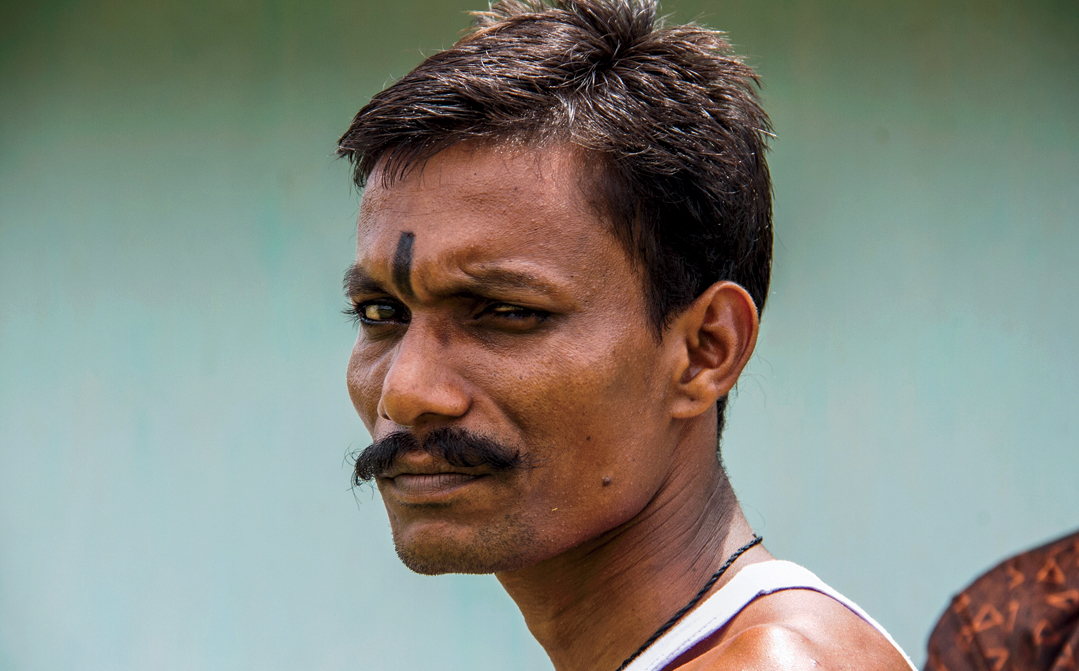
Sati Prasad protested the conditions of his displacement and faced brutal retaliation. Photo by Joe Athialy.
ONE OF THE LAST PEOPLE I MEET in Singrauli is a journalist named K.C. Sharma. For years, since long before Reliance Power built the Sasan project, Sharma has witnessed the entire region's plight, power station by power station. During the previous few months, he has been in and out of hospitals with an undiagnosed condition; he believes it is caused by chronic exposure to toxic fumes and particulate emitted by the nearby power plants. You can tell that Sharma was once a strong man and that he has lost a tremendous amount of weight. He is still quite handsome. His long fingers, curled over his knee, are encircled by large gold bands.
When Sharma was six months old, he tells me, his family was displaced by the Rihand Dam. The then prime minister, Jawaharlal Nehru, called the dam a temple of modern India. "People gave their land happily," Sharma says. "They thought their children and grandchildren would benefit." But his family was displaced again and again. He reels off the projects that forced them to move before the Sasan plant showed up: "Singrauli Super Thermal, Rihand Super Thermal, the railway that carries coal, the Kariya mines."
"The government publicizes this as the energy capital of India," he says. "It is the place where power comes from. They tell us we are martyrs for development. But we valorize martyrs. Nobody thinks about us. We are worse than refugees in our own country."
Sharma sits in a plastic chair, doused in the yellow light of a food stall. Every few minutes a truck carrying coal drives by, shedding dust.
"Now," he goes on, "most of the people are suffering from health problems. My eight-year-old daughter has kidney damage. Kidney failure is widespread. Asthma and respiratory disease. People losing hair, eyesight. Blood sugar and blood pressure problems." Sharma has written many articles on the plight of Singrauli, but, now in the sixth decade of his life, he sees little progress around him. His sunken eyes look down at his hands. He estimates that 40 percent of the people who've been displaced during his lifetime have simply vanished, unaccounted for. "Nobody knows where they have gone."
Another truck rumbles by. Sharma points into the orange glow of the night with his long arm. "On that side you see gardens, coal plants, big offices, and on this side you see nothing. Just dust. Every morning there is this much dust." He stretches his arms outward, as if to encompass everything around him. "We are part of the dust."
WHAT YOU CAN DO
Ask the Office of the Inspector General for the Export-Import Bank of the United States to meet with the people displaced by the Sasan project in their own communities, and to conduct a full investigation of the project's compliance with the Equator Principles, the International Finance Corporation Performance Standards, and the bank's social, environmental, human rights, and anticorruption policies.
 The Magazine of The Sierra Club
The Magazine of The Sierra Club

